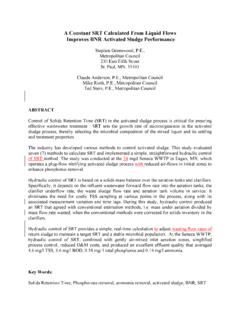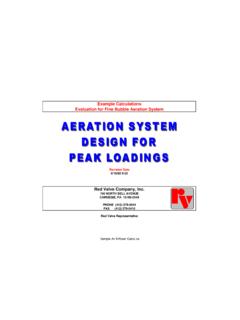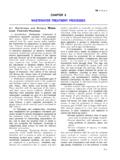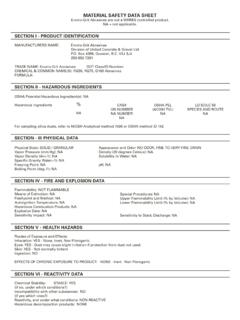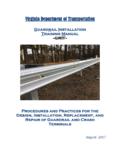Transcription of Introduction to Wastewater System Design and Practice ...
1 14/02/01 Assoc. Prof. to WastewaterSystem Design and PracticeSession 3 - Hydraulics of Grit Chambers14/02/01 Assoc. Prof. Grit may cause problems in: Pumps Sludge digestion Dewatering facilities In addition, it may settle out in downstream pipes and processes The grit removal process is carried out at an early stage of treatment because: The particles cannot be broken down by biological process The particles are abrasive and wear down equipment14/02/01 Assoc. Prof. Grit chambers are designed to remove inorganic solids > 2 mm Removal is commonly effected using: Settlement Separation using a vortex Settlement in the presence of aeration (to keep the lighter organic particles in suspension) There are important hydraulic principles associated with each of these14/02/01 Assoc.
2 Prof. In this lecture: The three main types of grit chamber are described The hydraulic aspects of the operation of each are described qualitatively and - where appropriate - quantitatively Design aspects are discussed14/02/01 Assoc. Prof. The choice of grit removal process depends largely on the size of the STP PE < 5,000 Horizontal flow (constant velocity) unit (utilises settling) 5,000 < PE < 10,000 Vortex type grit chamber PE > 10,000 Aerated grit chamber (vortex type may sometimes be used)14/02/01 Assoc. Prof. Whichever type is used, it is vital that the unit must operate over the full range of expected flows Other (non-hydraulic) Design considerations include: Grit removal from unit (manual or mechanical) Handling, storage, and disposal of grit Provision of standby or bypass facilities14/02/01 Assoc.
3 Prof. This is basically an open channel with a detention time sufficient to allow Design particles to settle Additionally, the velocity must be high enough to scour organic materials Organic materials should pass through the grit chamber for subsequent biological treatment14/02/01 Assoc. Prof. = The Camp-Shields equation is commonly used to estimate the scour velocity required to resuspend settled organic material where is the velocity of scour is particle diameter is an empirical constant is the Darcy - Weisbach friction factor is the particle density is the fluid densityvkgdfvdkfspsp8 14/02/01 Assoc.
4 Prof. Typically, this equation yields a required horizontal flow velocity of - m/sec Design recommendation is m/sec Primary hydraulic Design issue is: How do we ensure that this velocity will be maintained over a range of flows? We discuss the problem on the next slide vkgdfsp= 8 14/02/01 Assoc. Prof. ==== Assume a rectangular channel with the flow passing over a rectangular weir The discharge relationship for the weir is (Refer to notes from course on Design of Flow Measurement Systems) The horizontal velovity, , is related to the flow rate, , and channel geometry by Substituting for from the weir equation 13 QCBgHvQvQBhCgHHvCgQCgBdhhdhdd22223212121 4/02/01 Assoc.
5 Prof. ()()()()()()() Now, if the ratio of is 5:1 (a typical value), then the corresponding value of would be 5 = If m / sec is chosen for , the corresponding value of would be m / sec This is too large We must modify either the channel or the weir to maintain a satisfactory horizontal velocity13vCgQCgBvvQQQQ vvvvhddhhhhhh= = 221313maxminmaxminmaxminmaxminminmax14/0 2/01 Assoc. Prof. Before examining different methods of maintaining constant velocity, we examine ideal settling properties of a tank For simplicity, we assume a rectangular tank cross section14/02/01 Assoc.
6 Prof. The tank has four zones: Inlet zone Outlet zone Settling zone Sludge zone At this stage, we consider only the settling zone14/02/01 Assoc. Prof. == = The particle will travel vertically from A to B in the same time as it takes to travel horizontally from A to B This is the detention time and is given by Furthermore, (continuity)tHvLvvQBHdphh14/02/01 Assoc. Prof. is the surface area of the tank is termed the surface loading rate The equation shows that the basin Design is independent of depth The surface area of the tank is defined in terms of the flow rate and the particle settling velocitytHvLvvQBHvvHLQBHHLQBLBLQBL dphhph=== === 14/02/01 Assoc.
7 Prof. This equation indicates also that the sedimentation efficiency is independent of detention time in the basinvQBLp= This is not a mathematical oddity Consider a basin with the flow uniformly introduced over the surface area of the basin, resulting in an upflow velocity of v0 Any particle with a fall velocity> v0will be removed (settled) after being introduced, regardless of the detention time in the basin Likewise, any particle for whichvp<v0will eventually exit with the effluent overflowing from the basin14/02/01 Assoc. Prof. How can we modify the channel shape to keep the velocity constant for all flow rates? We assume that the channel discharges into a rectangular control section (eg a long-throated or Parshall flume) This device is used as a water level control and/or a flow measurement device14/02/01 Assoc.
8 Prof. = = == = Let be the width of the rectangular throat section in the long - throated flume ( is constant) The flow through the throat is: (refer to notes on Design of Flow Measurement Systems) (1) Within the channel: or Therefore the flow through an elemental horizontal strip of width in the channel is (2)wwQgwydQgwydyvQwyQvwywdQvwdytttthhh23 2332321214/02/01 Assoc. Prof. (1) (2) Solving this equation for : or constant This describes a parabola, indicating that a parabolic shape for the channel cross section will ensure constant regardless of flow ratedQgwydydQvwdygwydyvwdywwgwvywyvththt hh== = == 2323231212121214/02/01 Assoc.
9 Prof. Practical Design Hydraulics: To reduce construction costs, the parabolic shape is approximated with a trapezoid One channel and a bypass or two or more channels should be installed Determine Design flows Maximum Average Minimum Emergency (maximum flow with one channel out of service)14/02/01 Assoc. Prof. Turbulence occurs in the inlet zone as the flow is established A similar phenomenon occurs in the outlet zone as the flow streamlines turn upwards Normally a 25 - 50% increase in the calculated settling length is applied to allow for these14/02/01 Assoc. Prof. (m) onchannel areaand flow rateLength (m) 3 - 25 Function ofchannel depth &grit settling for in-& outlet25 - 50%Based ontheoreticallengthDetention atpeak flow15-90secsFunction ofvelocity andchannel lengthHorizontalvel.
10 (m/sec) specified inGuidelines forDevelopers14/02/01 Assoc. Prof. Design procedure for parabolic channel is illustrated in the notes with an example Hydraulic aspects of weir modification: We seek a weir which will promote a constant velocity through the grit channel, regardless of flow rate ie designed to give a linear relationship between flow rate and head on crest14/02/01 Assoc. Prof. Such a weir is called a Sutroor proportionalweir The weir can be used in conjunction with a rectangular grit channel to ensure a constant velocity at all flow rates14/02/01 Assoc. Prof. () Now, flow through the curved section is It can be shown that this is equivalent to where is the opening width at an elevation It is evident that a linear relationship is maintained if is kept constantQCghzxdzQCgLhLhQhLhdhd= = 21572012003212''.
